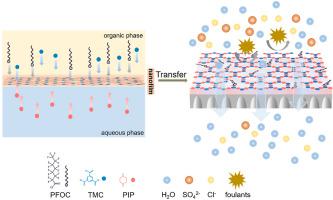Journal of Membrane Science ( IF 8.4 ) Pub Date : 2021-12-07 , DOI: 10.1016/j.memsci.2021.120166 Wenwen Li 1, 2 , Runnan Zhang 1, 2, 3 , Chao Yang 1, 2 , Zhen Wang 1, 2 , Jingyuan Guan 1, 2 , Yafei Li 1, 2 , Jianliang Shen 1, 2 , Yanlei Su 1, 2 , Zhongyi Jiang 1, 2, 3, 4

|
Nanofiltration (NF) membranes with high flux and superior antifouling performance are in great demand for water purification. Low-surface-energy fluorine materials have attracted significant attention in the fabrication of antifouling nanofiltration membranes. However, their inferior water affinity usually leads to the sacrifice of membrane water permeability. Herein, we explored perfluorooctanoyl chloride (PFOC) as a reactive additive in the organic phase during support-free interfacial polymerization (IP) to engineer fluorinated polyamide (FPA) nanofilms, which were further transferred onto porous substrates for thin-film composite (TFC) membranes. PFOC can participate in the interfacial polymerization process, leading to an enlarged pore size of the FPA nanofilm. The resultant TFC membrane displayed water permeance of 28.5 ± 0.7 L m−2 h−1 bar−1, about twice as high as that of the pure polyamide (PA) membrane while maintaining Na2SO4 rejection above 98.5% and NaCl rejection below 15.0%. Moreover, the existence of low-surface-energy perfluoroalkyl chains on the FPA nanofilm surface can endow the TFC membrane with superior antifouling properties with a higher flux recovery ratio and lower flux decline ratio against oil/water emulsions (FRR = 97.9%, DRt = 9.5%) and bovine serum albumin (FRR = 98.5%, DRt = 13.9%). Our approach may enlighten a new avenue on engineering high-flux antifouling TFC membranes with fluorine materials.
中文翻译:

用于海水淡化的高通量防污聚酰胺纳米膜的全氟辛酰氯工程
具有高通量和优异防污性能的纳滤 (NF) 膜在水净化中需求量很大。低表面能氟材料在防污纳滤膜的制备中引起了极大的关注。然而,它们较差的水亲和力通常会导致膜透水性的牺牲。在此,我们探索了全氟辛酰氯 (PFOC) 作为无载体界面聚合 (IP) 过程中有机相中的反应性添加剂,以设计氟化聚酰胺 (FPA) 纳米膜,并将其进一步转移到多孔基材上用于薄膜复合材料 (TFC)膜。PFOC 可以参与界面聚合过程,导致 FPA 纳米膜的孔径扩大。所得 TFC 膜的透水性为 28.5 ± 0.7 L m-2 h -1 bar -1,大约是纯聚酰胺 (PA) 膜的两倍,同时将 Na 2 SO 4截留率保持在 98.5% 以上和 NaCl 截留率低于 15.0%。此外,FPA纳米膜表面低表面能全氟烷基链的存在可以赋予TFC膜优异的防污性能,具有更高的通量恢复率和更低的对油/水乳液的通量下降率(FRR = 97.9%,DR t = 9.5%)和牛血清白蛋白(FRR = 98.5%,DR t = 13.9%)。我们的方法可能会为用氟材料设计高通量防污 TFC 膜开辟一条新途径。











































 京公网安备 11010802027423号
京公网安备 11010802027423号